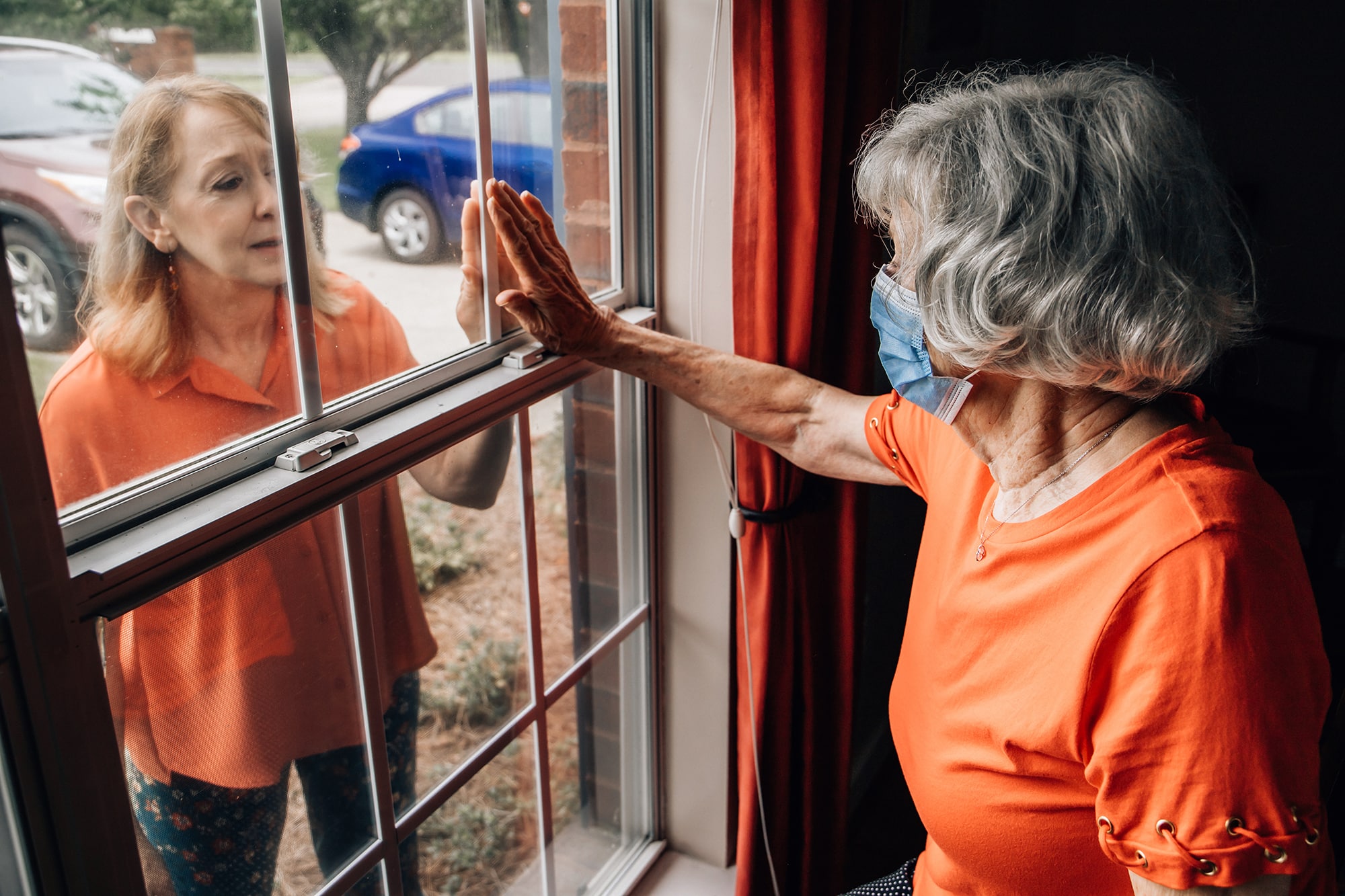
Credit: Adobe Stock
by Varshini Chellapilla
Peggy Williams has seen her husband only three times since March. Jack Williams, who was diagnosed with Alzheimer’s disease in 2013, is a resident at a long-term care facility that locked down at the very beginning of the coronavirus pandemic.
The last time they met, a plexiglass wall stood between them as they maintained a distance of six feet from one another. With Jack’s hearing problems, the masks, and the traffic from the road, Peggy had to yell to be heard.
“I didn’t even know that Jack started to gain a lot of weight and his clothes weren’t fitting him until the first time on the porch visit,” Peggy said. “Because I’d only seen him from the shoulders up on FaceTime. And Jack, of course, can’t communicate with me. His verbal skills are almost gone.”
At the end of the visit, Jack was upset. He couldn’t understand why his wife had to leave.
“They’ve kept Jack safe from COVID but, as far as emotionally and the mental toll, it’s been hell,” Peggy said. “It’s almost like he doesn’t exist anymore. The world just gets smaller and smaller, and it’s been really hard.”
Eight months ago, nursing homes and long-term care facilities all across the country locked down in an attempt to protect residents from the coronavirus pandemic. Soon, however, they became ground zero for the virus, making up for 39% of all COVID-19 deaths nationwide, according to The Covid Tracking Project. In Pennsylvania alone, 62% of deaths related to COVID-19 were reported from long-term care facilities.
“What happened in the nursing home setting was, is, and probably will be, in the next few weeks, a series of tragic events that revealed the faults in our system of long-term care in America,” said Dr. Jason Karlawish, MD, co-director of the Penn Memory Center.

Jason Karlawish, MD
Facilities had restricted contact between residents and the outside world, halted volunteer-based programs, and quarantined residents in small spaces for their safety.
However, a survey conducted by Altarum, a nonprofit organization aiming to improve health among vulnerable populations, showed how nursing home residents have been emotionally and mentally affected by the pandemic restrictions. The survey, administered between early July and August 2020, revealed that 76% of respondents reported feeling lonelier under the restrictions and 64% of them do not leave their rooms to socialize with other residents.
Peggy’s struggle to see her husband echoed the sentiments of several caregivers who have gone many months without meeting their loved ones.
“With Jack, we would get FaceTime visits,” Peggy said. “Then, there were window visits and then, porch visits at a table with plexiglass between us. That was the progression.”
The Altarum survey also noted that social interactions both outside and inside the facilities have dropped significantly. While 93% of respondents reported not leaving their nursing homes within a week, 54% responded that they had not been participating in any in-home activities.
Dr. Karlawish stressed that the pandemic revealed the importance of providing good care to older adults in long-term care facilities.
“What happens when you give bad care is people do poorly,” Dr. Karlawish said. “In the case of persons living with dementia and residents in long-term care facilities, they lost weight, developed agitation, became ill independent of COVID-19, and got sicker. Many of them died. And it was because the care they were getting wasn’t the kind of care they needed.”
A report by the Government Accountability Office released in May found that 82% of nursing homes had infection control deficiencies prior to the pandemic. This involves situations where staff members did not implement proper hygienic methods or preventative measures in the case of infectious disease outbreaks.
Facilities like Jack’s have become overwhelmed by short-staffed human resources, inability to obtain proper personal protection equipment, and the need to keep their residents engaged. Staff members and pair caregivers working in nursing homes are also often underpaid and under-rewarded, Dr. Karlawish said. Moreover, the pandemic showed how vulnerable the staff at long-term care facilities and nursing homes were.
“The staff are individuals who often have to travel long commutes, using public transportation as opposed to driving, and often live with other folks who are doing similar work. And they themselves, then, became victims of COVID-19,” Dr. Karlawish said. “So COVID-19 revealed how, in long-term care facilities, the care that we provide is so fragile because it’s under-resourced and understaffed.”
At PMC, the Caregiver Forums offer an opportunity for caregivers with loved in long-term facilities and nursing homes to share grievances and advice with each other.
“I’ve been most impressed with PMC and I’m glad they’re looking at it, and trying to do things about it,” Peggy said. “Because the only thing you can hope is that someone somewhere, who can do things about this, are learning from this situation and can make some changes that will be better for everybody.”
The facility that Peggy’s husband resides in closed again in November amid rising concerns of a “second wave.” With the number of cases once again rising, she doesn’t expect to see Jack in-person any time soon.